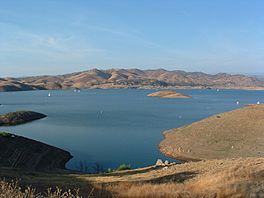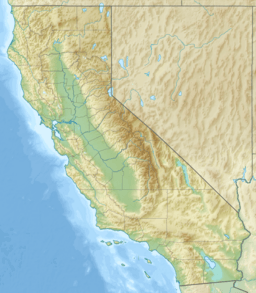Millerton Lake facts for kids
Quick facts for kids Millerton Lake |
|
|---|---|
 |
|
| Location | Sierra Nevada Fresno- / Madera-Counties, California |
| Coordinates | 37°02′33″N 119°39′16″W / 37.0425°N 119.6545°W |
| Type | Reservoir |
| Primary inflows | San Joaquin River |
| Primary outflows | Friant-Kern Canal Madera Canal San Joaquin River |
| Catchment area | 1,675 sq mi (4,340 km2) |
| Basin countries | United States |
| Surface area | 4,900 acres (2,000 ha) |
| Max. depth | 319 ft (97 m) |
| Water volume | 520,528 acre⋅ft (0.642062 km3) |
| Surface elevation | 561 ft (171 m) |
Millerton Lake is a large, man-made lake in California. It is located near the town of Friant, about 15 miles (24 km) north of downtown Fresno. This lake was created by building the 319-foot (97 m) high Friant Dam on the San Joaquin River. The lake and the dam form much of the border between Fresno County to the south and Madera County to the north.
Before the dam was built, the area where the lake now sits was home to the town of Millerton. This town was actually the first county seat for Fresno County.
Contents
Why Millerton Lake Was Built
The Friant Dam is part of a bigger plan called the Central Valley Project. This project helps manage water resources in California. The dam was built by the United States Bureau of Reclamation (USBR). It was mostly finished in 1942, with the final parts added in 1947.
What the Lake Does
Millerton Lake holds a lot of water, about 520,528 acre-feet (0.642 km³). Its main job is to store water for irrigation. This means it provides water to farms in the San Joaquin Valley so they can grow crops. The water travels through two main channels: the Madera Canal and the Friant-Kern Canal.
Besides irrigation, the lake also helps with other important things:
- Flood Control: It helps prevent floods by holding back excess water during heavy rains.
- Recreation: People enjoy activities like swimming, fishing, water skiing, and camping at the lake.
- Electricity: A hydroelectric power plant at the dam makes electricity from the water that is released.
- Fish Hatchery: Smaller amounts of water are released to help a fish hatchery, which raises fish.
Fish Safety at Millerton Lake
The California Office of Environmental Health Hazard Assessment has given advice about eating fish from Millerton Lake. This is because some fish in the lake have higher levels of mercury. It is important to follow their guidelines to stay safe when eating fish caught there. You can find more information on their website.
Impact on the Environment
Building the Friant Dam changed the San Joaquin River a lot. Most of the river's water is now sent to farms. This has caused about 60 miles (97 km) of the river to become dry. It only flows during very wet years when there's too much water for the dam to hold.
Changes to River Life
When the river dries up, it harms the natural areas along its banks. It has also greatly reduced the number of chinook salmon that used to swim up the river. There used to be about 15,000 salmon each year. Less water in the river also means that pollution from farm chemicals, like pesticides and fertilizers, becomes more concentrated. This further harms the fish and other water creatures.
Working Towards Restoration
After many years of discussions, environmental groups, fishermen, and the USBR agreed on a plan in 2006. This plan aims to release some of the water back into the San Joaquin River. The goal is to help bring the river and its native fish and wildlife back to health.
The first water for this restoration was released in 2009. By 2014, these "restoration flows" were increased. This project will help the river, but it also means that farms will receive a little less water from the dam.



